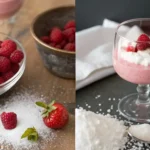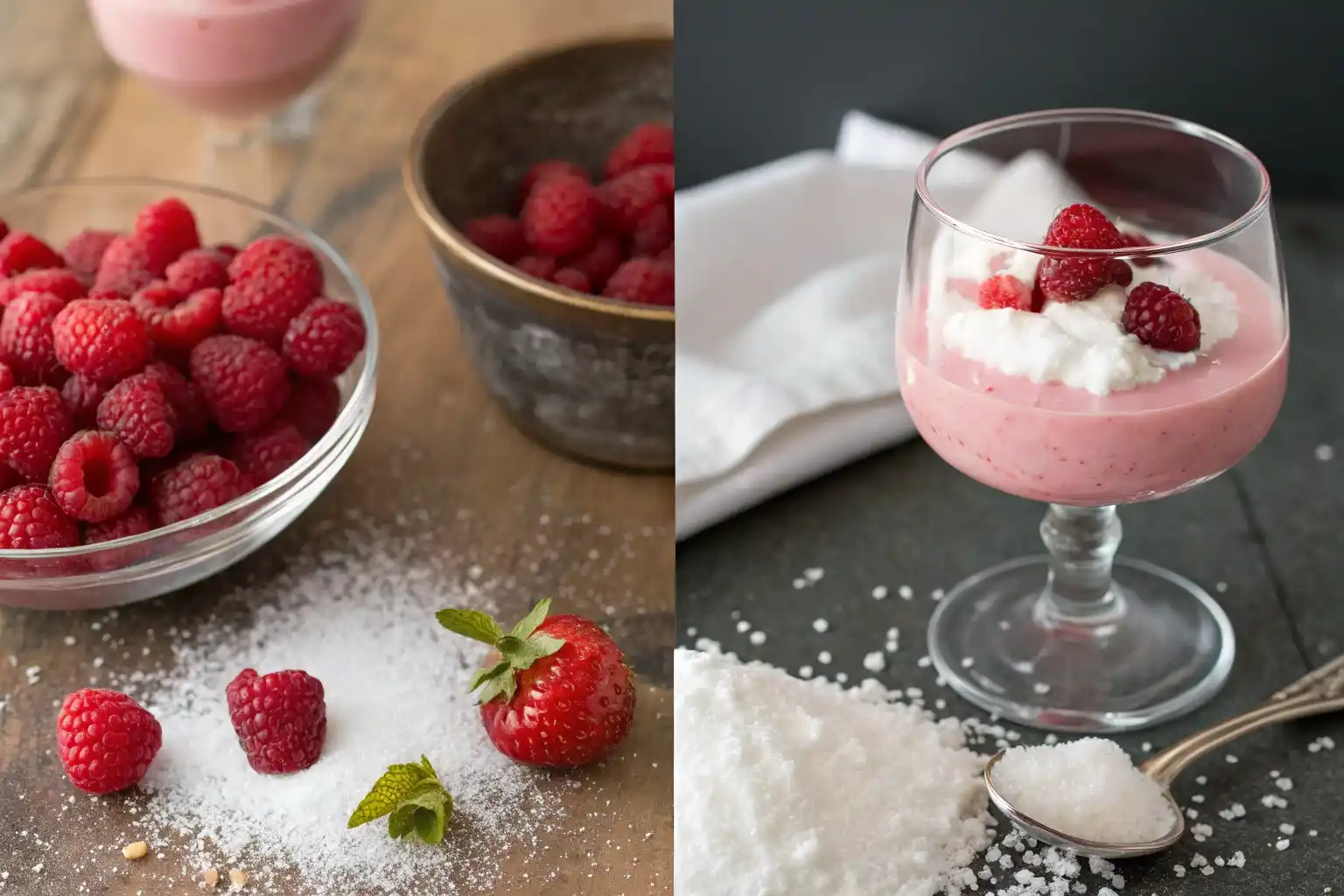The Anatomy of a Food Trend
In the fast-paced world of social media, food trends can explode overnight, capturing the attention of millions and transforming simple recipes into global phenomena. Raspberry spuma is the latest dessert to achieve viral status, joining the ranks of whipped coffee, baked feta pasta, and cloud bread. But what makes a recipe go viral, and how can food creators harness the power of social media to share their culinary creations with the world? This article explores the fascinating world of viral food trends, using raspberry spuma as a case study, and provides practical tips for content creators looking to make their mark in the digital culinary landscape.
The Rise of Raspberry Spuma: A Viral Success Story
The Perfect Storm of Virality
Raspberry spuma didn’t become a sensation by accident. Several factors aligned to create the perfect conditions for viral success:
- Visual Appeal: The transformation from deep red raspberry mixture to pale pink, cloud-like foam is visually striking and satisfying to watch. This dramatic change provides the “wow factor” that social media algorithms favor.
This dramatic transformation, combined with the healthy summer desserts appeal of the recipe, creates content that performs well across multiple audience segments.
- Simplicity: With just three ingredients and a five-minute preparation time, the recipe is accessible to virtually anyone. This low barrier to entry encourages widespread participation and recreation.
The basic raspberry spuma recipe requires no special equipment or hard-to-find ingredients, making it accessible to creators worldwide regardless of their kitchen setup or local grocery options.
- Timing: The recipe gained traction during summer months when people were craving light, refreshing treats and had more time to experiment in the kitchen.
- Shareability: The recipe is easy to explain in a short video format, making it perfect for platforms like TikTok and Instagram Reels.
The Social Media Lifecycle
The viral journey of raspberry spuma followed a predictable pattern:
1.Origin: Food influencers and home cooks began sharing their versions
2.Early adoption: Food enthusiasts tried and shared their results
3.Mainstream breakthrough: Major food accounts and celebrities joined the trend
4.Peak saturation: The hashtag exploded with millions of views and attempts
5.Evolution: Creators began developing variations and improvements
6.Integration: The recipe became part of the permanent social media food lexicon
What Makes Food Content Go Viral?
Visual Elements
Transformation videos: Content that shows a dramatic before-and-after transformation performs exceptionally well. The raspberry spuma’s color change from deep red to pale pink is a perfect example.
Satisfying textures: Videos featuring smooth, creamy, or fluffy textures tap into the ASMR trend and provide visual satisfaction.
Bright, appealing colors: Vibrant, Instagram-worthy colors catch the eye and encourage sharing.
Perfect plating: Even simple recipes benefit from thoughtful presentation and styling.
Content Structure
Hook within 3 seconds: Successful food videos grab attention immediately with compelling visuals or intriguing text overlays.
Clear, simple steps: Viewers should be able to understand and replicate the recipe easily.
Satisfying payoff: The final result should look delicious and achievable.
Optimal length: Most viral food content is between 15-60 seconds, perfect for short attention spans.
Psychological Triggers
FOMO (Fear of Missing Out): Trending recipes create urgency—people want to try them before the trend passes.
Achievement satisfaction: Successfully recreating a viral recipe provides a sense of accomplishment.
Community participation: Joining a food trend creates a sense of belonging to a larger community.
Nostalgia and comfort: Many viral foods tap into comfort food memories or childhood favorites.
Platform-Specific Strategies
TikTok
Algorithm-friendly elements:
Use trending sounds and music
Include popular hashtags (#FoodTok, #Recipe, #Viral)
Post during peak hours (6-10 PM in your target timezone)
Encourage engagement through questions or challenges
Content tips:
Start with a hook: “POV: You only have 3 ingredients but want dessert”
Show the process in real-time or slightly sped up
Include text overlays with ingredient lists or tips
End with a satisfying taste test or reaction
Feed posts:
High-quality, well-lit photos of the final product
Carousel posts showing step-by-step process
Professional styling and composition
Detailed captions with full recipes and tips
Reels:
Similar to TikTok content but potentially longer (up to 90 seconds)
Use Instagram’s built-in editing tools and effects
Include trending audio and hashtags
Cross-promote to Stories for maximum reach
Stories:
Behind-the-scenes content and process videos
Polls and questions to encourage engagement
Recipe cards and quick tips
User-generated content reposts
YouTube
Short-form content (Shorts):
60-second recipe videos
Quick tips and hacks
Trending recipe attempts and reviews
Long-form content:
Detailed recipe tutorials
Technique explanations and troubleshooting
Recipe variations and improvements
Collaboration videos with other creators
Creating Your Own Viral Food Content
Recipe Development
Start with a strong foundation: Your recipe should be genuinely good, not just visually appealing.
Test thoroughly: Ensure your recipe works consistently before sharing it with the world.
Consider variations: Develop multiple versions to extend the content lifecycle.
Document everything: Keep detailed notes on ingredients, techniques, and timing.
Content Planning
Identify your unique angle: What makes your version different or special?
Plan your shots: Storyboard your video to ensure you capture all necessary elements.
Prepare your setup: Good lighting and clean backgrounds are essential.
Have backup plans: Technical issues happen—be prepared with alternative approaches.
Filming Tips
Lighting is everything: Natural light is best, but invest in good artificial lighting if needed.
Stable shots: Use a tripod or phone stand for steady footage.
Multiple angles: Capture overhead shots, close-ups, and side angles.
Audio quality: Clear audio is crucial, especially for longer-form content.
Editing and Post-Production
Keep it snappy: Quick cuts and smooth transitions maintain viewer interest.
Add value: Include helpful text overlays, measurements, and tips.
Color correction: Ensure your food looks as appetizing as possible.
Sound design: Choose music that matches your content’s energy and mood.
Building a Following Through Food Content
Consistency is Key
Regular posting schedule: Maintain a consistent presence on your chosen platforms.
Brand development: Develop a recognizable style and voice.
Quality over quantity: It’s better to post less frequently with higher quality content.
Engagement Strategies
Respond to comments: Build relationships with your audience through genuine interaction.
User-generated content: Encourage followers to share their attempts and repost the best ones.
Collaborations: Partner with other food creators for cross-promotion.
Live content: Host live cooking sessions or Q&A sessions.
Monetization Opportunities
Brand partnerships: Work with food brands and kitchen equipment companies.
Affiliate marketing: Earn commissions by promoting products you genuinely use and love.
Digital products: Create recipe e-books, meal plans, or online courses.
Physical products: Develop your own food products or branded merchandise.
The Future of Viral Food Trends
Emerging Platforms
BeReal: Authentic, unfiltered food content is gaining traction.
Pinterest: Recipe discovery and meal planning continue to grow.
Clubhouse: Audio-only cooking discussions and live recipe sharing.
Technology Integration
AR filters: Augmented reality tools for recipe visualization and instruction.
AI-powered recommendations: Personalized recipe suggestions based on dietary preferences.
Smart kitchen integration: Recipes that work with connected appliances and devices.
Sustainability Focus
Zero-waste cooking: Recipes that minimize food waste are increasingly popular.
Plant-based alternatives: Vegan and vegetarian versions of popular recipes.
Local and seasonal: Emphasis on locally sourced, seasonal ingredients.
Lessons from Raspberry Spuma’s Success
Key Takeaways
1.Simplicity wins: The most viral recipes are often the simplest ones.
2.Visual transformation is powerful: Dramatic changes capture attention and encourage sharing.
3.Timing matters: Seasonal relevance can amplify a recipe’s viral potential.
4.Community builds momentum: User-generated content and variations extend a trend’s lifespan.
5.Accessibility is crucial: Recipes that anyone can make have the broadest appeal.
Applying These Lessons
When developing your own viral food content, consider:
How can you create visual drama or transformation?
What makes your recipe uniquely simple or accessible?
How does your content fit into current trends or seasonal preferences?
What elements encourage viewers to try and share the recipe themselves?
Conclusion: The Recipe for Viral Success
The success of raspberry spuma demonstrates that viral food trends aren’t just about luck—they’re about understanding what resonates with audiences and delivering content that meets their needs for entertainment, inspiration, and achievable success. Whether you’re a professional chef, food blogger, or home cook with a smartphone, the tools for creating viral content are more accessible than ever.
The key is to focus on creating genuinely valuable content that people want to share, try, and talk about. Combine this with smart use of social media platforms, consistent posting, and authentic engagement with your audience, and you’ll be well on your way to creating the next viral food sensation.
Remember, while going viral can provide incredible exposure and opportunities, the most sustainable success comes from building genuine relationships with your audience and consistently delivering content that adds value to their lives. The raspberry spuma trend will eventually fade, but the creators who built authentic communities around comprehensive content—from basic recipes to specialized variations to seasonal adaptations—will continue to thrive long after the hashtags stop trending.
Print
Raspberry Spuma
A light and refreshing dessert that transforms a deep red raspberry mixture into a fluffy pink foam, perfect for summer.
- Total Time: 35 minutes
- Yield: 4 servings 1x
Ingredients
- 1 cup fresh raspberries
- 2 tablespoons sugar
- 1 cup heavy cream
Instructions
- Blend raspberries and sugar together until smooth.
- In a separate bowl, whip the heavy cream until stiff peaks form.
- Fold the raspberry mixture into the whipped cream until just combined.
- Spoon into serving dishes and refrigerate for at least 30 minutes before serving.
Notes
Feel free to garnish with additional raspberries or mint leaves for presentation.
- Prep Time: 5 minutes
- Cook Time: 0 minutes
- Category: Dessert
- Method: Chilling
- Cuisine: French
- Diet: Vegetarian
Nutrition
- Serving Size: 1 serving
- Calories: 250
- Sugar: 7g
- Sodium: 50mg
- Fat: 20g
- Saturated Fat: 12g
- Unsaturated Fat: 8g
- Trans Fat: 0g
- Carbohydrates: 20g
- Fiber: 2g
- Protein: 3g
- Cholesterol: 70mg
Keywords: raspberry spuma, summer dessert, viral recipes, easy dessert, light dessert

